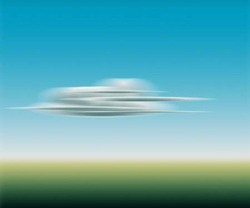Technique & Meaning
By Terrington Calas, NEW ORLEANS ART REVIEW
[EXCERPT]

"Front 31", 2004
. . . Texas photographer Ted Kincaid, exhibiting concurrently at Arthur Roger, seems to reexplore one aspect of the old Romantic impulse — its penchant for exalting the look of nature. Of course, Kincaid’s methods, it must quickly be said, are decidedly of our time. So are his results: computer-manipulated photographs, polished and over-scaled and, above all, luminous with electronic-age color.
For [Kincaid], . . .a sort of technique obsession is central to what [he does].
. . .
There is no question that Ted Kincaid manipulates and toys with technique. Some might say it is the true subject of his pictures, not the cloudscapes that covered Arthur Roger’s walls last month. In spite of this, those nature images are what we actually saw. And they are startlingly beautiful. Unnaturally beautiful. They lend a latter-day significance to the old principle “picturesque”— the ideal of studied and irregular beauty. Kincaid’s take on technique relates to this. His work, in part, explores the way technique is used in the service of recasting nature.
This is hardly a new posture. Despite the striking contemporary look of these pictures, they follow a long tradition of artistic enhancement of the observed world. Consider the obvious instances: Leonardo”s softened and refined form via sfumato, the Romantics” aggrandized landscape, especially the American versions of painters such as Thomas Cole and Frederick Church and; or even the domestic world of Matisse, a heightened and sweetened world that never existed. In every case there is the question of art striving for Eden. Artists in pursuit of an idealized world.
In Kincaid’s cloud photographs, nature is idealized for today’s techno-centric eyes — glowing, insistent color and perfected form. No real clouds were ever so stunning. Nor were painted ones. One thinks immediately of the English Romantic Constable and his celebrated cloud studies. We prize them for the animated brushwork, the way his singular touch is evident as he approximates yet glorifies nature. For Kincaid, touch is replaced with electronics and pictorial invention. In a piece such as Front 31, the skies are newly vivid, newly ordered, populated with mesmerizing forms that are clouds in name only. Here, the glorification of nature reads as a kind of romanticism for the machine age.

"Front 63", 2004
In the most powerful 19th century Romantics — the Germans and Turner — there is usually a layered conception of nature. There is grandeur, certainly, but also a palpable aura of discomfort, perhaps of melancholy. Nature’s majesty and beauty are accompanied by allusions to our own frailty, our own fate. Nothing of this is in Kincaid’s photographs. What he offers instead is an art of the brain and of a remarkable new era. It has little to do with human emotions. It does, however, assert the notion that art can stem from, and can reflect, humankind’s enduring sense of wonder. We reach for the new because we must. If there is a metaphorical subtext in these pictures, it has to do with the intelligence of advancing both technology and technique.
